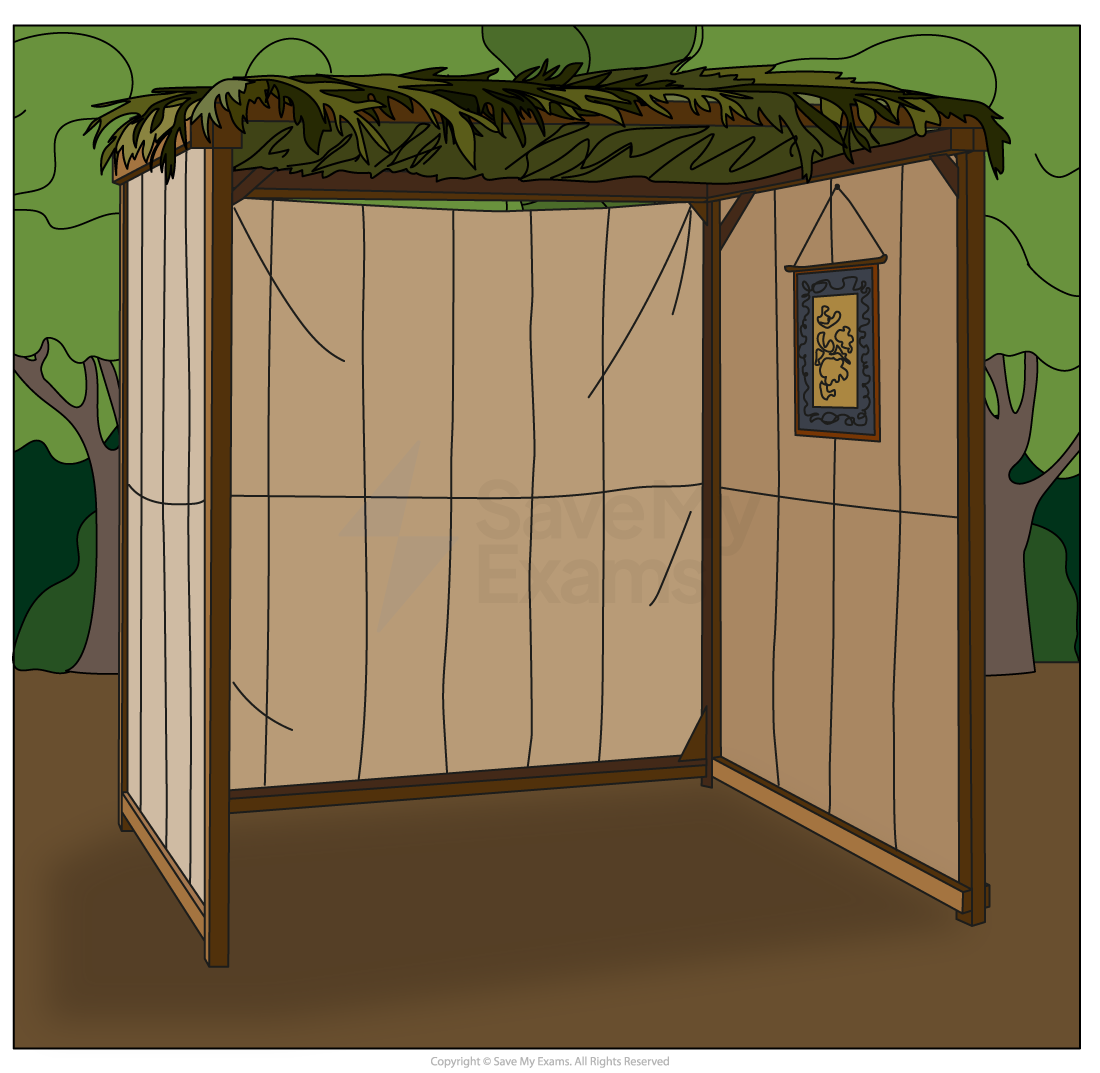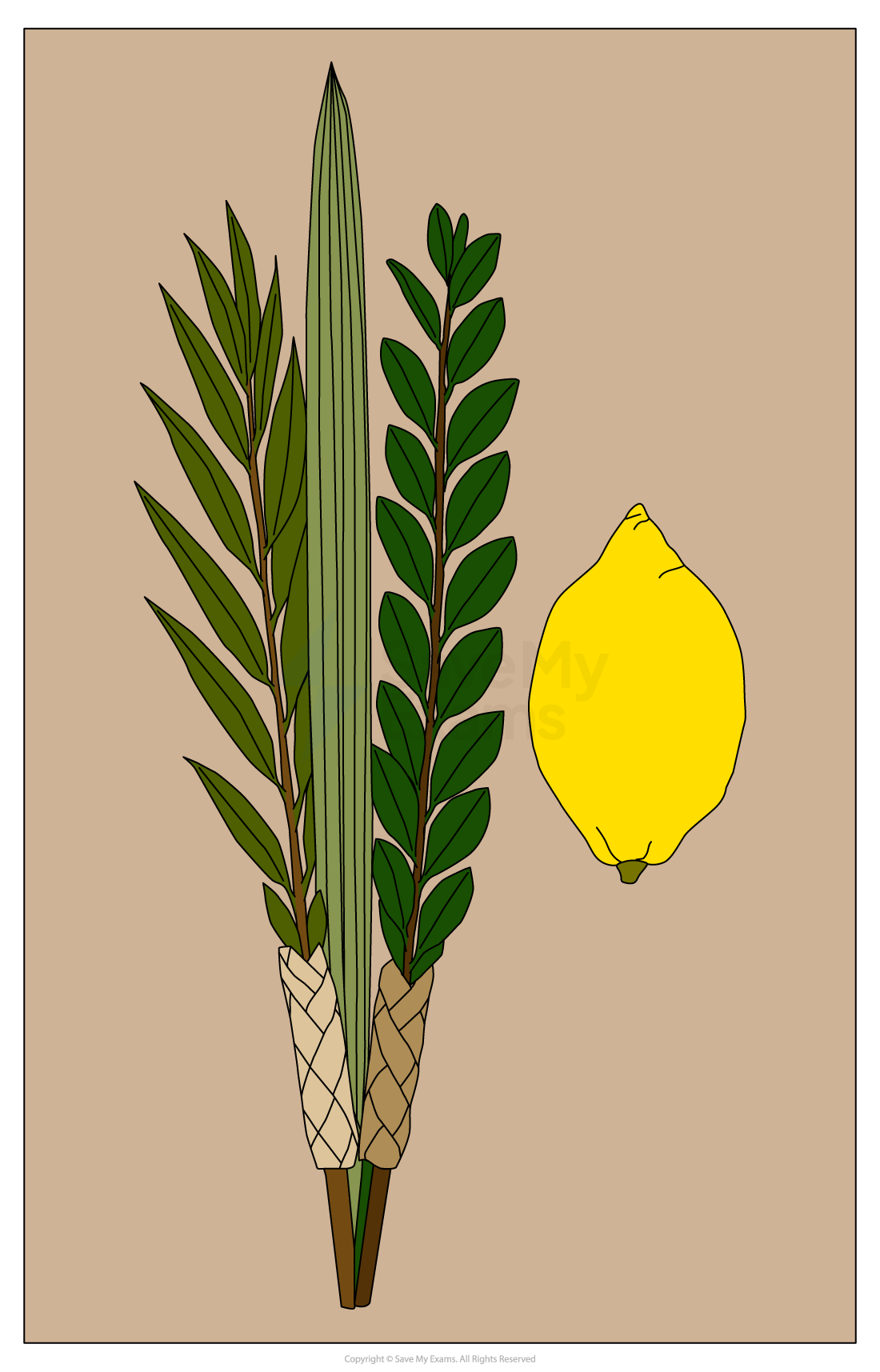Sukkot (Cambridge (CIE) IGCSE Religious Studies): Revision Note
Exam code: 0490
What is the festival of Sukkot?
Sukkot (also known as the Festival of Tabernacles or Booths) is a festival celebrated by Jewish people around the world
The festival:
Reminds Jews to be thankful for the things they have
Lasts for seven days in Israel and eight days outside Israel
Is a harvest festival
Is a time to remember the Israelites’ time in the wilderness after the Exodus, when Moses led them out of slavery in Egypt
People celebrate Sukkot at home and at a synagogue with family and friends
There is a large meal at the end
Sukkot involves many religious practices that contain symbolic meaning
The festival ends with a special service at the synagogue
During the service, people pray and hit the ground with sticks of willow leaves five times to get rid of any bad luck or sin
The service is followed by a celebratory meal for family and friends
The significance of building & using a sukkah
Many people celebrate Sukkot by building a sukkah
A sukkah is a temporary hut that has a roof made of plants and leaves

Families spend time in the sukkah during the Sukkot festival
The sukkah reminds Jewish people of the temporary homes made by Moses and the Israelites during their 40 years of wandering in the desert after the Exodus from Egypt
Spending time in the sukkah is also a way for Jews to honour their ancestors
The sukkah must be unstable enough to remind people of the fragility of life and dependence on G-d
During the festival, families eat meals inside the sukkah
Some people choose to sleep in it as well
What are the Four Species?
Sukkot also involves the Four Species (Arba Minim)
The Four Species are a citrus fruit called an etrog (which is a bit like a lemon) and a lulav
The lulav is a palm branch, but during Sukkot, it refers to a bundle of three plants:
Palm branch (lulav)
Myrtle (hadass)
Willow (aravah)
The Four Species are waved each day of Sukkot (except Shabbat)
Why are the Four Species waved?
The lulav is a reminder of G-d’s presence everywhere
The lulav is waved in six directions: north, south, east, west, up and down
This symbolises that G-d is present all around and rules over the whole world
The lulav also demonstrates the unity of the Jewish people, as each plant represents different aspects of the Jewish people:
Etrog (taste and smell): Jews who study the Torah and do good deeds
Lulav (taste only): those with learning but not deeds
Hadass (smell only): those who do good but do not study
Aravah (neither): those who lack both

Waving the lulav also represents the Jewish people giving thanks for the autumn harvest
It is a form of praise and prayer to G-d for providing food and sustenance
The religious reasons for observing Sukkot
There are many religious reasons why Jews observe Sukkot
Waving the Four Species is fulfilling a Mitzvah (commandment) from the Torah
“And you shall take ... the fruit of beautiful trees, branches of palm trees, boughs of leafy trees, and willows ... and rejoice before the Lord your G-d” (Leviticus 23:40)
Sukkot also remembers the wilderness journey of the Israelites
During this time, they lived in temporary shelters, protected by G-d
“You shall live in booths for seven days … so your generations may know that I made the Israelites live in booths when I brought them out of the land of Egypt” (Leviticus 23:42–43)
It is a time to thank G-d for the harvest
Sukkot is also a time when Jewish people demonstrate trust in G-d
Living in a fragile sukkah reminds Jews to rely on G-d for protection, not material things
The social reasons for observing Sukkot
Sukkot also has social significance. It can strengthen family bonds, community life and a sense of shared identity
During the festival, families build, decorate and eat meals together in the sukkah
Many families invite friends and guests, creating a joyful and welcoming atmosphere
This helps to strengthen family traditions and memories across generations
Welcoming other people into the sukkah is a mitzvah (good deed)
This includes symbolically welcoming the seven biblical guests who are regarded as the leaders of the Jewish people:
Abraham
Isaac
Jacob
Moses
Aaron
Joseph
David
Sukkot can strengthen community ties
Synagogues and Jewish communities hold communal meals, events and services
Everyone shares in the celebration, which builds unity and belonging
The event helps to educate children about Jewish history and traditions
Children help with building and decorating the sukkah
The experience teaches Jewish values and practices in an enjoyable and sociable way
It also helps Jews to celebrate a shared identity
Jews around the world celebrate Sukkot at the same time, in similar ways
This helps to reinforce a global sense of community and continuity of tradition
Different ways Sukkot is observed within Judaism
All Jews celebrate Sukkot, but there may be some differences in the ways in which it is celebrated between denominations
Orthodox Judaism and Sukkot
Orthodox Jews follow halakhah (Jewish law) very strictly and so show complete obedience to the Torah laws and traditional practices
This involves building a kosher sukkah at home or in the community and eating all meals there
Some also sleep in the sukkah (weather permitting)
During Sukkot, they use all Four Species (lulav, etrog, hadass, aravah) daily (except Shabbat)
Prayers are mostly in Hebrew, with full synagogue services throughout the week
Reform Judaism and Sukkot
Reform Jews still observe Sukkot but often with more flexibility
They may build a sukkah and eat meals in it, but not everyone will sleep there
Some may use the Four Species, while others may focus more on the symbolism
Services may be shorter and include more English than Hebrew
There may be a greater focus on the ethical themes of the festival, such as gratitude and protection
Worked Example
Give two reasons why Jews observe Sukkot
[2 marks]
Answer:
To give thanks to G-d for providing food and protection [1]
To remember the 40 years that the Jews spent in the wilderness [1]
Examiner Tips and Tricks
Understand the key concepts: Master the historical background, symbolism and ritual practices associated with Sukkot
Use evidence: Refer to specific examples from the Torah, the Hebrew Bible or Jewish traditions to support your answers
Organise your answer: Structure your answer logically, using headings and subheadings to present your points clearly
Practice: Review past exam questions and practice answering them to familiarise yourself with the exam format and style

Unlock more, it's free!
Did this page help you?